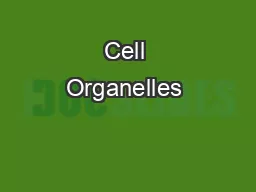

Plasma Membrane Recall what is a plasma membrane A cells outer boundary Found in both plant amp animal cells In a plant cell lies beneath the cell wall In animal cells the outer boundary made of cholesterol ID: 469661
Download Presentation The PPT/PDF document "Cell Organelles & Features" is the property of its rightful owner. Permission is granted to download and print the materials on this web site for personal, non-commercial use only, and to display it on your personal computer provided you do not modify the materials and that you retain all copyright notices contained in the materials. By downloading content from our website, you accept the terms of this agreement.
Slide1
Cell Organelles & FeaturesSlide2
Plasma Membrane
Recall: what is a plasma membrane?
A cell’s outer boundary
*Found in both plant & animal cellsIn a plant cell: lies beneath the cell wallIn animal cells: the outer boundary (made of cholesterol)Provides cell with:ProtectionControl of movement of materials in and out of cellSupportMaintains condition of cellSlide3
Membrane Lipids
Primarily made of phospholipids that have hydrophilic head and hydrophobic tail
Create a phospholipid bilayer
Cell membranes in eukaryotes contain lipids called sterolsImportant because it helps make the membrane more firm & keeps it from freezing at low temperaturesSlide4
Nucleus
Recall: What is a nucleus?
Membrane-bound organelle that contains a cell’s DNA
*Found in both plant & animal cellsMost of the functions of a eukaryotic cell are controlled by the nucleusHouses and protects the cell’s genetic information (DNA)The site where DNA is transcribed into RNASlide5
Nuclear Envelope
Nucleus is surrounded by a double membrane called the
nuclear envelope
Made up of two phospholipid bilayersNucleolusThe site where DNA is concentrated when it is making ribosomal RNA; makes ribosomesSlide6
Mitochondria
*Found in both plant & animal cells
Mitochondria
: tiny organelles that transfer energy from organic molecules to adenosine triphosphate (ATP)Have their own DNA (called mitochondrial DNA)Have an inner and outer phospholipid bilayerInner membrane has many folds called cristaeCristae contain proteins that carry out energy-harvesting chemical reactionsSlide7
Ribosomes
*Found in both plant & animal cells
Ribosomes
: small, roughly spherical organelles that are responsible for building proteinDo not have a membraneMade of protein and RNA moleculesAssembly begins in the nucleolus and is completed in the cytoplasmSome are free within the cytosol & some are attached to the rough endoplasmic reticulumSlide8
Endoplasmic Reticulum
*Found in both plant & animal cells
Endoplasmic reticulum (ER)
: a network of membranous tubes and sacs, called cisternaeLocated next to the nucleusFunctions primarily as an intracellular highway Transports materials throughout the cellTwo types:Smooth (no ribosomes)Rough (covered with ribosomes)Slide9
Golgi Apparatus
*Found in both plant & animal cells
Golgi apparatus
: network of flattened, membranous sacs that processes and packages molecules, like lipids and proteins, that were made by the cellProteins get “address labels” that direct them to the other parts of the cellSlide10
Lysosomes
*Found in
animal cells only!
Lysosomes: vesicles that bud from the Golgi apparatus and that contain digestive enzymesBreak down large molecules, such as proteins, nucleic acids, carbohydrates, and phospholipidsResponsible for breaking down cells when it is time for the cell to diePlay an important role in maintaining an organism’s health by destroying cells that are no longer functioning properlySlide11
Cytoskeleton
*Found in both plant & animal cells
Cytoskeleton
: network of thin tubes and filaments that crisscrosses the cytosolStrengthen cell & maintains the shapeMoves organelles within the cell*Note: Only animal cells have special microtubules called centrioles
that are important for cell divisionSlide12
*Features Unique to Plant Cells
Plant cells have three additional kinds of structures that are extremely important to plant function:
Cell walls
Large central vacuolesPlastidsSlide13
Cell Wall
Cell wall
: a rigid layer that lies outside the cell’s plasma membrane
Main component of the cell wall is celluloseSome plants also produce a secondary cell wallSlide14
Central Vacuole
Central vacuole
: large, fluid-filled organelle that stores not only water but also enzymes, metabolic wastes, and other materials
Can make up 90% of the plant cell’s volumeHelps to keep the plant tissue firm*Note: animal cells have vacuoles, but they are very small in comparison to plant cell vacuolesSlide15
Plastids
Plastids
: organelles surrounded by a double membrane and contain their own DNA
Several types of plastids, including chloroplasts, chromoplasts, and leucoplastsSlide16
Chloroplasts
Use light energy to make carbohydrates from carbon dioxide and water
Contains a system of flattened, membranous sacs called
thylakoidsThylakoids contain a green pigment called chlorophyllChlorophyll: the main molecule that absorbs light and captures light energy for the cellSlide17
Plant Cells vs. Animal Cells
Cell wall present
Large central vacuole
Plastids (chloroplasts)Larger in sizeFixed shapeLysosomesCentriolesVacuoles are very smallSmaller in sizeNo definite shape
Plant Cell
Animal CellSlide18Slide19
Cell City
The Cell Song